Morphological and molecular re-assessment of European and Levantine species of the genus Hortiboletus (Boletaceae)
- PMID: 40546449
- PMCID: PMC12179652
- DOI: 10.3897/imafungus.16.144731
Morphological and molecular re-assessment of European and Levantine species of the genus Hortiboletus (Boletaceae)
Abstract
Hortiboletus (the former Xerocomusrubellus species complex) is one of the most taxonomically critical and difficult genera for species identification in the family Boletaceae. Here, we provide a detailed morphological and molecular re-assessment of European and Levantine species of Hortiboletus. A new species, H.hershenzoniae, is described from Israel. It is sister to H.engelii and associated with the evergreen oak Quercuscalliprinos and potentially also with Q.ithaburensis. Based on the sequence retrieved from INSDC, this species is also found in Lebanon. Accurate morphological descriptions, comprehensive sampling, type studies, biogeography, macro- and microphotographs and a historical overview on the nomenclatural issues surrounding H.rubellus, H.bubalinus, H.engelii, and H.hershenzoniae are given. An epitype collection is designated for H.rubellus. A key is provided for identification of the European and Levantine taxa. In addition, we propose a novel taxonomic combination Hortiboletusflavorubellus, which is conspecific with Boletusrubellusvar.flammeus, based on the DNA barcoding and phylogenetic analysis of type material. Boletusharrisonii is also shown to be conspecific with H.campestris. A multilocus phylogenetic analysis of four markers (ITS, LSU, tef1-α, and rpb2) reveals that Hortiboletus is a sister genus to Xerocomellus. Using the Genealogical Concordance Phylogenetic Species Recognition method, at least 19 phylogenetic species and eight putative phylogenetic species of the genus Hortiboletus can be delimited. Based on multilocus analysis, it contains from 24 to 25 species-level clades worldwide, 17 out of which represent known species, one newly described and potentially six to seven undescribed species. Tandem repeat insertions within the ITS region (both in ITS1 and ITS2) are reported for the first time, not only in the genus Hortiboletus, but in the entire subfamily Boletoideae. Their identification and characterisation were based on Tandem Repeat Finder analysis and visual assessment of the ITS alignment.
Keywords: Agaricomycetes; Boletales taxonomy; biogeography; diversity; phylogeny; xerocomoid fungi.
Alona Yu. Biketova, Tatyana Yu. Svetasheva, Andy F. S. Taylor, Giampaolo Simonini, Matteo Gelardi, Olga V. Morozova, Elias Polemis, José A. Muñoz, László Albert, Salvatore Saitta, Solomon P. Wasser, Eviatar Nevo, Georgios I. Zervakis, Alfredo Vizzini, Bálint Dima.
Conflict of interest statement
The authors have declared that no competing interests exist.
Figures

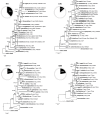

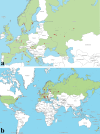
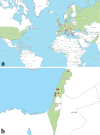
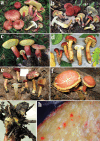
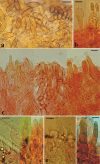


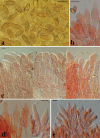

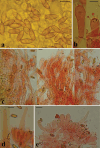

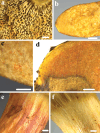
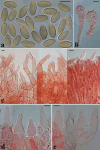
Similar articles
-
Classification of Aspergillus, Penicillium, Talaromyces and related genera (Eurotiales): An overview of families, genera, subgenera, sections, series and species.Stud Mycol. 2020 Jun 27;95:5-169. doi: 10.1016/j.simyco.2020.05.002. eCollection 2020 Mar. Stud Mycol. 2020. PMID: 32855739 Free PMC article.
-
A rapid and systematic review of the clinical effectiveness and cost-effectiveness of topotecan for ovarian cancer.Health Technol Assess. 2001;5(28):1-110. doi: 10.3310/hta5280. Health Technol Assess. 2001. PMID: 11701100
-
Home treatment for mental health problems: a systematic review.Health Technol Assess. 2001;5(15):1-139. doi: 10.3310/hta5150. Health Technol Assess. 2001. PMID: 11532236
-
Signs and symptoms to determine if a patient presenting in primary care or hospital outpatient settings has COVID-19.Cochrane Database Syst Rev. 2022 May 20;5(5):CD013665. doi: 10.1002/14651858.CD013665.pub3. Cochrane Database Syst Rev. 2022. PMID: 35593186 Free PMC article.
-
Survivor, family and professional experiences of psychosocial interventions for sexual abuse and violence: a qualitative evidence synthesis.Cochrane Database Syst Rev. 2022 Oct 4;10(10):CD013648. doi: 10.1002/14651858.CD013648.pub2. Cochrane Database Syst Rev. 2022. PMID: 36194890 Free PMC article.
References
-
- Ainsworth AM, Fortey R, et al. (2024) Chapter 5: Fungi (excluding lichens). In: The biodiversity and natural history of Blenheim’s High Park / Ed. Farjon A. Exeter: Pelagic Publishing, 94–113. 10.53061/OZOM2670 - DOI
-
- Ainsworth AM, Smith JH, et al. (2013) Red List of Fungi for Great Britain: Boletaceae – A pilot conservation assessment based on national database records, fruit body morphology and DNA barcoding. Species Status 14. Joint Nature Conservation Committee, Peterborough, 37 pp.
-
- Akulov OYu, Prydiuk MP. (2007) The preliminary checklist of boletoid fungi of Ukraine. Pagine di Micologia 27: 117–144.
-
- Albert L. (2003) Colour Pages: Xerocomuscommunis (Bull.) Bon. Mikológiai Közlemények, Clusiana 42(3): 53–54.
-
- Albert L. (2004) Colour Pages: Xerocomusbubalinus (Oolbekk. et Duin) Redeuilh. Mikológiai Közlemények, Clusiana 43(1–3): 87–88.
LinkOut - more resources
Full Text Sources
